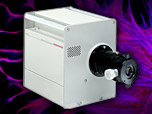Image Galleries
Featured Article
 Electron Multiplying Charge-Coupled Devices (EMCCDs)
Electron Multiplying Charge-Coupled Devices (EMCCDs)
By incorporating on-chip multiplication gain, the electron multiplying CCD achieves, in an all solid-state sensor, the single-photon detection sensitivity typical of intensified or electron-bombarded CCDs at much lower cost and without compromising the quantum efficiency and resolution characteristics of the conventional CCD structure.
Product Information
Interactive Java Tutorials
Streak Lifetime Imaging (FLIM) Camera
An optical image with intensity information at every pixel is converted to a streak image with spatial information displayed on the horizontal axis and time on the vertical axis. Every point in a streak image provides information representing intensity, location, and time. The CCD detector creates a point-by-point map of this information for evaluation.
In the tutorial illustrated above, a series of optical pulses arrive at the slit with varying intensity and also in terms of time and space. As the corresponding photoelectrons generated by the photocathode pass between the pair of sweep electrodes, the applied sweep voltage steers the electron paths away from the horizontal direction at different angles, depending upon their arrival time at the electrodes. The amplified electrons reach the phosphor screen and form an image oriented in the vertical direction according to the arrival time at the sweep electrodes. The earliest pulse is arranged in the uppermost position and the latest pulse is in the bottom most portion of the phosphor image. The resulting streak image has space as the x-axis and time as the y-axis.






